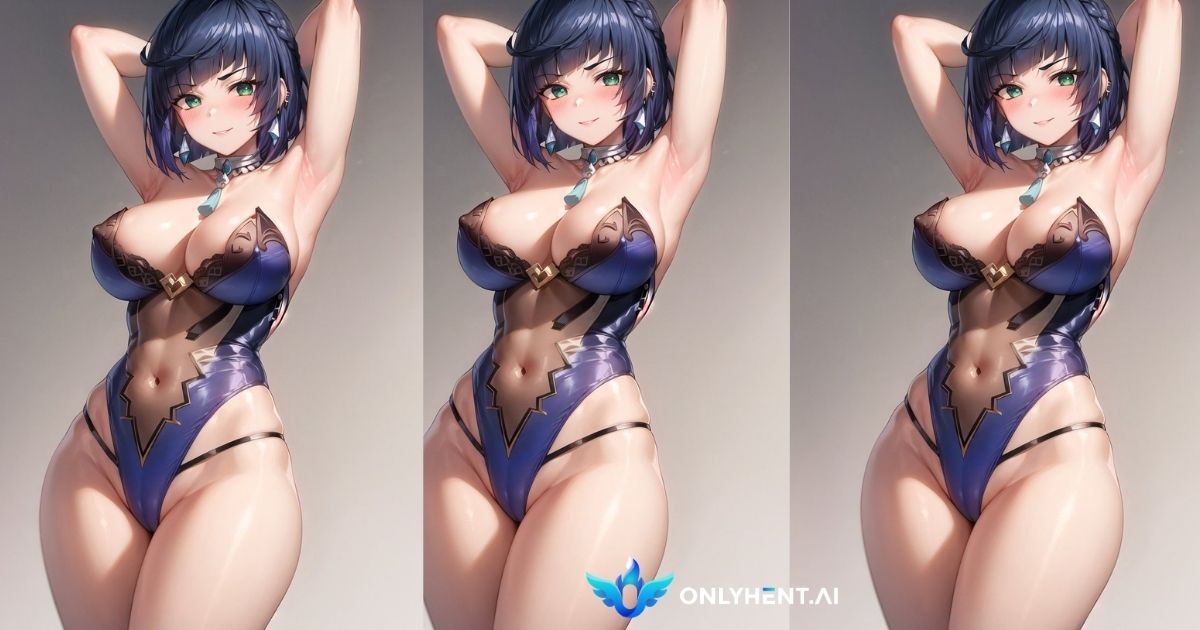Futanari and Tentacle Art stand as unique genres within the realm of erotic imagination. Futanari, often referred to as ‘futa,’ involves characters with both male and female anatomical features, adding a fascinating layer to traditional gender norms. On the other hand, Tentacle Art explores the intriguing world of fantastical creatures and their intimate encounters, creating a distinctive niche within erotic art. These genres captivate audiences with their unconventional and imaginative elements, offering a departure from conventional portrayals of sensuality.
Cultural Significance
Historical Roots in Japanese Art
Futanari and Tentacle Art find their roots in the rich tapestry of Japanese artistic traditions. Dating back to ancient times, these genres draw inspiration from the expressive and often provocative world of Shunga, a form of traditional Japanese erotic art. Shunga’s influence on Futanari and Tentacle Art becomes a testament to the enduring nature of these themes, reflecting a cultural openness to exploring the boundaries of sensuality through visual storytelling.
Shunga’s Influence on Erotic Imagery
Shunga, with its explicit depictions and exploration of taboo subjects, has played a pivotal role in shaping the trajectory of erotic imagery in Japan. It paved the way for the emergence of Futanari and Tentacle Art, serving as a historical foundation for artists to push the boundaries of artistic expression. The influence of Shunga echoes through the ages, contributing to the cultural significance of Futanari and Tentacle Art as contemporary extensions of Japan’s longstanding exploration of sensuality in art.
In delving into the distinctive elements and cultural significance, Futanari and Tentacle Art emerge as not only artistic expressions but also as products of a cultural legacy that has embraced the exploration of human sensuality across centuries.
Historical Context of Futanari and Tentacle Themes
Exploration of Taboos in Historical Context
In the annals of traditional Japanese art, Futanari and Tentacle themes found their early expressions in the form of Shunga. These explicit and often taboo-shattering depictions served as a window into the societal attitudes of the time. Futanari, with its blending of male and female attributes, and Tentacle Art, with its fantastical elements, provided a means of exploring sensual boundaries that were otherwise restricted in more conventional artistic representations. The exploration of taboos during this historical period laid the groundwork for the enduring appeal of Futanari and Tentacle Art.
Shunga’s Role in Breaking Conventional Norms
Shunga, as a genre, played a revolutionary role in breaking free from the constraints of conventional norms. The artistic revolution it initiated encompassed a departure from conservative portrayals of sexuality. Shunga’s embrace of explicit and imaginative themes, including those of Futanari and Tentacle Art, reflected a cultural openness to exploring the diversity of human sensuality. This period of artistic liberation paved the way for the evolution of these themes over the centuries, leaving an indelible mark on the trajectory of Japanese erotic art.
Evolution of Themes Over Centuries
Shifts in Artistic Expression
As centuries unfolded, the themes of Futanari and Tentacle Art underwent a nuanced evolution in response to shifting artistic expressions. From the scrolls and woodblock prints of the past to contemporary digital art, the depiction of Futanari and Tentacle scenarios adapted to the changing mediums and aesthetics of different eras. This evolution reflects not only the endurance of these themes but also their capacity to resonate with artists and audiences across diverse artistic landscapes.
Cultural Reception and Adaptation
The evolution of Futanari and Tentacle Art is intertwined with the cultural reception and adaptation of these themes over time. As Japan underwent periods of modernization and cultural exchange, these themes continued to captivate artists and audiences. The adaptability of Futanari and Tentacle Art to societal changes underscores their cultural relevance, providing a unique lens through which to explore not only sensuality but also the cultural dynamics of the broader Japanese artistic landscape.
In examining the historical context of Futanari and Tentacle themes, it becomes evident that their roots in traditional Japanese art, particularly Shunga, have played a crucial role in shaping their enduring significance. The exploration of taboos, the breaking of conventional norms, and the evolution of these themes over centuries showcase their resilience and ongoing relevance in the rich tapestry of Japanese artistic expression.
Modern Interpretations
Transition to Modern Manga and Anime
In the contemporary landscape of erotic art, Futanari and Tentacle themes have seamlessly transitioned into modern mediums, particularly finding a significant home in manga and anime. The dynamic storytelling capabilities of these mediums provide artists with a canvas to explore the complexities of Futanari and Tentacle scenarios in vibrant and imaginative ways. This transition has not only sustained the genres but also catapulted them into the global spotlight, reaching audiences far beyond the borders of Japan. The visual storytelling power of modern manga and anime has become a conduit for the continued exploration and evolution of Futanari and Tentacle Art.
Impact on Global Erotic Art Communities
The global embrace of Futanari and Tentacle Art is evident in their impact on the broader erotic art community. With the accessibility of digital platforms and the interconnectedness of the internet, artists and enthusiasts from around the world engage in a vibrant exchange of ideas, styles, and interpretations. Futanari and Tentacle themes, once niche expressions, have become influential components of the global erotic art discourse. This interconnectedness fosters a diverse and dynamic community that celebrates the rich tapestry of human sensuality through these unique artistic expressions.
Fusion of Futanari and Tentacle Themes
Artistic Styles and Approaches
In the fusion of Futanari and Tentacle themes, artists employ a wide array of styles and approaches that contribute to the genres’ contemporary allure. From traditional hand-drawn illustrations to digitally rendered artworks, artists showcase their creativity through diverse techniques. The styles range from highly detailed and realistic depictions to more abstract and fantastical representations. This diversity of artistic styles ensures that Futanari and Tentacle Art remain dynamic and appealing to a broad audience, transcending traditional boundaries of artistic expression.
Themes Explored in Modern Creations
Modern Futanari and Tentacle Art delve into a myriad of themes that reflect the ever-evolving nature of these genres. Artists explore not only the explicit and sensual aspects but also broader narratives that touch upon identity, fantasy, and societal dynamics. The themes encompass a spectrum of emotions, from playful and consensual scenarios to more intense and fantastical explorations. This breadth of themes contributes to the genres’ ability to resonate with a diverse audience, offering nuanced and captivating perspectives on human sensuality in the modern era.
In embracing modern interpretations, Futanari and Tentacle Art have seamlessly integrated into contemporary mediums, leaving an indelible mark on global erotic art communities. The transition to manga and anime has expanded their reach, while the fusion of themes showcases the genres’ adaptability and enduring appeal. The impact on global communities reaffirms the cultural significance of Futanari and Tentacle Art in shaping the discourse on erotic expression in the modern world.
Cultural and Artistic Influences
Relationship with Japanese Pop Culture
The relationship between Futanari and Tentacle Art and Japanese pop culture is prominently showcased through their seamless integration into manga and anime. These genres, once considered niche, have become integral components of Japan’s vibrant cultural tapestry. Manga and anime, with their widespread popularity both domestically and internationally, have provided a platform for artists to explore the complexities of Futanari and Tentacle themes. The visual storytelling prowess of these mediums allows for nuanced and imaginative narratives, contributing to the genres’ cultural integration and making them accessible to a diverse and global audience.
Influence on Contemporary Media
Beyond the realms of manga and anime, Futanari and Tentacle Art have exerted a notable influence on contemporary media. Elements and themes from these genres have permeated various forms of entertainment, including video games, literature, and even fashion. The impact extends to artistic collaborations, where creators draw inspiration from the visual language of Futanari and Tentacle Art to infuse a sense of creativity and boundary-pushing into their respective fields. This cultural influence underscores the genres’ ability to transcend traditional artistic boundaries and contribute to the broader landscape of contemporary media.
Artistic Freedom and Expression
Futanari and Tentacle Art emerge as powerful agents in breaking traditional gender and sexual norms within the realm of artistic expression. The fusion of male and female attributes in Futanari challenges conventional notions of gender, offering a space for artists to explore diverse identities and representations. Similarly, Tentacle Art, with its fantastical and otherworldly scenarios, provides an avenue for artists to push the boundaries of conventional sexual norms. The genres, therefore, become vehicles for the celebration of artistic freedom, allowing creators to challenge societal expectations and offer alternative perspectives on sensuality.
Role of Futanari and Tentacle Art in Pushing Boundaries
Futanari and Tentacle Art play a vital role in pushing artistic boundaries and expanding the horizons of creative expression. By delving into unconventional and fantastical themes, artists within these genres challenge societal taboos and preconceptions surrounding sexuality. The deliberate breaking of boundaries becomes a form of artistic activism, fostering a space where creators can explore uncharted territories without fear of societal constraints. This role in pushing boundaries not only enriches the genres themselves but also contributes to the broader discourse on the importance of artistic freedom and diversity in expression.
In examining the cultural and artistic influences of Futanari and Tentacle Art, their integration into Japanese pop culture and impact on contemporary media stand out. The genres’ ability to break gender and sexual norms, coupled with their role in pushing artistic boundaries, positions them as dynamic and influential contributors to the evolving landscape of artistic expression.
Exploration of Gender and Identity
Futanari themes within erotic art go beyond the traditional boundaries of gender, offering a unique space for the exploration of identity. The fusion of male and female characteristics in Futanari characters provides artists with a canvas to challenge societal norms surrounding gender binaries. This exploration extends beyond the physical attributes, delving into the intricacies of self-identity and challenging conventional understandings of what it means to be male, female, or a combination of both. Futanari, within the realm of erotic art, becomes a visual language for artists to express diverse facets of gender identity and offer a more inclusive representation.
Artistic Representation of Futanari Characters
The artistic representation of Futanari characters is a nuanced exploration that goes beyond mere physical attributes. Artists skillfully navigate the portrayal of Futanari individuals, capturing the essence of their identity with a focus on beauty and individuality. Futanari characters become more than a combination of genders; they embody a spectrum of emotions, desires, and expressions. The artistic representation within Futanari themes reflects a celebration of diversity and challenges conventional beauty standards, contributing to a broader cultural dialogue about inclusivity and acceptance.
Tentacle Themes
Origins in Mythology and Folklore
The origins of tentacle themes in erotic art can be traced back to mythology and folklore, particularly in East Asian traditions. Creatures with tentacle-like appendages, such as the Japanese mythological creature known as the “Tengu,” have historical roots in artistic depictions. Tentacle themes, therefore, draw inspiration from these ancient narratives, creating a bridge between cultural history and contemporary artistic expression. The incorporation of tentacles into erotic art becomes a symbolic continuation of a rich cultural legacy, blending mythical elements with modern sensibilities.
Symbolism and Interpretations in Erotic Art
Tentacle themes within erotic art carry diverse symbolism and interpretations, adding layers of meaning to the visual narratives. Beyond their physicality, tentacles often symbolize themes of desire, intimacy, and the fantastical. Artists infuse their creations with symbolic representations that transcend the literal, inviting viewers to explore a realm where imagination intertwines with sensuality. The tentacle becomes a versatile element, capable of conveying various emotions and narratives, making it a unique and evocative feature within the broader spectrum of erotic art.
In exploring the themes of Futanari and Tentacle Art, the genres become not only expressions of sensuality but also platforms for the examination of gender, identity, mythology, and symbolism. The artistic representations within these themes contribute to a rich and nuanced discourse on diversity, cultural heritage, and the limitless possibilities of creative expression within the realm of erotic art.
Visual Elements in Futanari Art
Depiction of Futanari Anatomy
The visual elements within Futanari art extend beyond the conventional, offering a unique exploration of anatomy. Artists skillfully navigate the depiction of Futanari characters, emphasizing the harmonious blend of male and female features. The artistry lies not only in the explicit portrayal but in capturing the beauty and fluidity of this amalgamation. Through thoughtful representation, Futanari art becomes a celebration of diverse anatomical possibilities, challenging traditional norms and fostering a visual language that reflects the intricacies of human sensuality.
Stylization and Visual Appeal
Stylization plays a pivotal role in the visual appeal of Futanari art. Artists employ diverse techniques, from traditional hand-drawn illustrations to digital rendering, each contributing to a distinctive visual language. Stylization goes beyond the anatomical aspects, encompassing the overall aesthetic of the artwork. Whether embracing realism or adopting more abstract styles, Futanari art showcases a spectrum of visual approaches that captivate audiences. The diversity in stylization ensures that Futanari art remains dynamic, resonating with a broad audience appreciative of various artistic expressions.
Tentacle Art’s Creative Possibilities
Imaginative Scenarios and Designs
Tentacle art unleashes a realm of imaginative scenarios and designs, where the fantastical intertwines with sensuality. Artists delve into creative possibilities, crafting scenarios that go beyond traditional constraints. Tentacles become dynamic elements, weaving through the compositions in ways that evoke intrigue and captivation. Whether exploring underwater fantasies or otherworldly landscapes, Tentacle art provides a canvas for artists to let their imaginations run wild, resulting in visually stunning creations that transcend the boundaries of reality.
Use of Tentacles as Artistic Elements
The tentacle itself becomes an artistic element in Tentacle art, offering a versatile and evocative feature. Artists explore the tactile nature of tentacles, using them to convey emotions, desires, and interactions. The movement, shape, and texture of tentacles add layers of visual interest, contributing to the overall impact of the artwork. As artistic elements, tentacles bring a sense of dynamism and fluidity to the compositions, elevating Tentacle art beyond mere explicit depictions to a realm where creativity and sensuality converge.
Reception and Controversies
Positive Appreciation in Erotic Art Communities
Futanari and Tentacle Art evoke diverse reactions within the erotic art communities, with a significant segment expressing positive appreciation. These genres have found a devoted audience appreciative of their unique storytelling, imaginative scenarios, and the artistic exploration of sensuality. In these communities, artists and enthusiasts engage in discussions, share interpretations, and celebrate the creative expressions within Futanari and Tentacle themes. The positive reception reflects an acknowledgment of the genres’ contribution to the broader landscape of erotic art and the recognition of the artistic freedom they afford.
Criticism and Taboos Surrounding the Themes
Concurrently, Futanari and Tentacle Art face criticism and encounter societal taboos due to the unconventional themes they explore. Some segments of the audience, influenced by cultural norms or personal preferences, may view these genres with skepticism or discomfort. The explicit nature and fantastical elements within these themes challenge conventional sensibilities, leading to varied reactions. It’s important to note that the criticism often stems from differing perspectives on what constitutes acceptable artistic expression, contributing to an ongoing dialogue about the boundaries of erotic art.
Ongoing Debates on Artistic Freedom
The legal and censorship challenges contribute to ongoing debates about artistic freedom within the context of Futanari and Tentacle Art. Advocates argue for the importance of protecting freedom of expression, asserting that artists should have the liberty to explore unconventional and explicit themes without undue restrictions. These debates prompt a broader conversation about the role of art in pushing societal boundaries and challenging preconceptions. As legal frameworks continue to adapt, there is an opportunity for a more nuanced approach that balances artistic freedom with the need to address cultural sensitivities.
Community and Subculture
Supportive Spaces for Artists and Enthusiasts
Futanari and Tentacle Art have given rise to vibrant online communities and platforms that serve as supportive spaces for artists and enthusiasts. These digital hubs provide a dedicated environment where creators can showcase their work, engage in discussions, and receive feedback from like-minded individuals. The supportive nature of these communities fosters a sense of camaraderie among artists, encouraging the exchange of ideas and techniques. Enthusiasts, in turn, find these platforms as spaces to appreciate and explore the diverse expressions within Futanari and Tentacle themes, creating a virtual ecosystem that transcends geographical boundaries.
Global Networking and Collaboration
The online nature of communities dedicated to Futanari and Tentacle Art facilitates global networking and collaboration. Artists from different parts of the world can connect, share insights, and collaborate on projects, contributing to a cross-cultural exchange of ideas. This global connectivity expands the reach of Futanari and Tentacle subcultures, allowing for a diverse array of artistic influences and interpretations. The collaborative spirit within these communities reflects the dynamic nature of erotic art as a global phenomenon, where artists and enthusiasts come together to celebrate and explore the unique themes within these genres.
Evolution of Futanari and Tentacle Subcultures
Subgenres and Niche Communities
The evolution of Futanari and Tentacle subcultures has led to the emergence of subgenres and niche communities within the broader landscape of erotic art. Artists often explore specific themes, styles, or narrative elements within Futanari and Tentacle themes, giving rise to niche communities that cater to these specialized interests. Whether it’s subgenres exploring particular fetishes or niche communities focused on specific artistic approaches, the subcultures within Futanari and Tentacle Art showcase the genres’ adaptability and the diverse preferences within their audience. This evolution contributes to a rich tapestry of subcultural expressions that celebrate the nuances of erotic artistic exploration.
Conclusion
In concluding the exploration of Futanari and Tentacle Art, a recapitulation of their evolution underscores the genres’ transformative journey. From their historical roots in Japanese art to the modern digital age, Futanari and Tentacle Art have undergone a remarkable evolution. The genres have transitioned from niche expressions to influential contributors within the broader landscape of erotic art. The recapitulation serves as a testament to the resilience and adaptability of Futanari and Tentacle themes, showcasing their ability to captivate audiences across diverse cultural and artistic contexts.
Reflecting on the cultural, artistic, and social impact of Futanari and Tentacle Art unveils a multifaceted influence. Culturally, these genres integrate into the global discourse, drawing inspiration from Japanese traditions while contributing to a universal exploration of sensuality. Artistically, Futanari and Tentacle Art challenge norms, pushing the boundaries of creative expression and providing a canvas for diverse identities and narratives. Socially, the impact is evident in the creation of online communities, fostering global connections and collaborative endeavors. The genres, through their impact, become more than artistic expressions—they become catalysts for conversations about cultural diversity, artistic freedom, and the evolving nature of societal perceptions.
The acknowledgment of the diverse and evolving nature of Futanari and Tentacle Art is crucial in appreciating their ongoing significance. These genres continually adapt to changing artistic trends, audience preferences, and cultural dynamics. The acknowledgment extends to the genres’ ability to encompass a broad spectrum of themes, styles, and narratives, catering to a diverse audience with varied interests. By recognizing the evolving nature of Futanari and Tentacle Art, we embrace the genres as dynamic forms of artistic expression that contribute to the rich tapestry of human creativity and the ever-expanding landscape of erotic art.
In conclusion, Futanari and Tentacle Art emerge not just as artistic genres but as cultural phenomena that transcend boundaries, spark conversations, and celebrate the diversity of human sensuality. The recapitulation, reflection, and acknowledgment encapsulate the enduring impact of these genres, inviting continued exploration and dialogue within the evolving realm of erotic artistic expression
Check detailed information on Erotic Art.
- Cultural Significance
- Historical Context of Futanari and Tentacle Themes
- Evolution of Themes Over Centuries
- Modern Interpretations
- Fusion of Futanari and Tentacle Themes
- Cultural and Artistic Influences
- Exploration of Gender and Identity
- Tentacle Themes
- Visual Elements in Futanari Art
- Tentacle Art's Creative Possibilities
- Reception and Controversies
- Community and Subculture
- Evolution of Futanari and Tentacle Subcultures
- Conclusion









